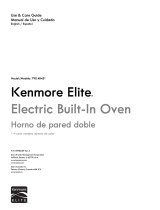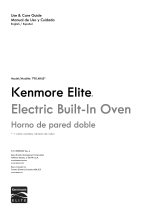
Table of Contents
Please carefully read and save these instructions ............................... 2
Before Setting Surface Controls .................................................................. 9
Setting Surface Burners ............................................................................... 13
Before Setting Oven Controls .................................................................... 14
Setting Oven Controls ................................................................................ 16
Care and Cleaning ...................................................................................... 34
Cleaning Various Parts of Your Oven ................................................. 34
Replacing the Oven Light ...................................................................... 36
Removing and Replacing the Oven Door ........................................... 37
Porcelain enameled glide racks ........................................................... 39
Before You Call ........................................................................................... 40
Oven Baking ............................................................................................ 40
Solutions to Common Problems ............................................................. 41
Please carefully read and save these instructions
This Use and Care Manual contains general operating instructions for your appliance and feature information for several models. Your product may
not have all the described features. The graphics shown are representative. The graphics on your appliance may not look exactly like those shown.
Common sense and caution must be practiced when installing, operating, and maintaining any appliance.
KENMORE ELITE LIMITED WARRANTY
WITH PROOF OF SALE, the following warranty coverage applies when this appliance is correctly installed, operated and
maintained according to all supplied instructions.
FOR ONE YEAR from the date of sale this appliance is warranted against defects in material or workmanship. A defective
appliance will receive free repair or replacement at option of seller.
FOR TWO YEARS from the date of sale, a free replacement part will be supplied for a ceramic cooktop that fails due to thermal
shock or for a ceramic cooktop heating element that is defective. After the first year from the sale date you are responsible for the
labor cost of part installation.
For warranty coverage details to obtain free repair or replacement, visit the web page: www.kenmore.com/warranty
All warranty coverage applies for only 90 DAYS from the sale date if this appliance is ever used for other than private household
purposes.
This warranty covers ONLY defects in material and workmanship, and will NOT pay for:
1.
2.
3.
4.
5.
6.
8.
9.
10.
11.
12.
Cracks in a ceramic glass cooktop that are not a result of thermal shock.
Stains and scratches on a ceramic glass cooktop resulting from accident or improper operation or maintenance.
Discoloration of cooktop surfaces resulting from normal use.
Expendable items that can wear out from normal use, including but not limited to filters, belts, bags or screw-in base light bulbs.
A service technician to clean or maintain this appliance, or to instruct the user in correct appliance installation, operation and
maintenance.
Service calls to correct appliance installation not performed by Sears authorized service agents, or to repair problems with
house fuses, circuit breakers, house wiring, and plumbing or gas supply systems resulting from such installation.
Damage to or failure of this appliance resulting from installation not performed by Sears authorized service agents, including
installation that was not in accord with electrical, gas or plumbing codes.
Damage to or failure of this appliance, including discoloration or surface rust, if it is not correctly operated and maintained
according to all supplied instructions.
Damage to or failure of this appliance, including discoloration or surface rust, resulting from accident, alteration, abuse, misuse
or use for other than its intended purpose.
Damage to or failure of this appliance, including discoloration or surface rust, caused by the use of detergents, cleaners,
chemicals or utensils other than those recommended in all instructions supplied with the product.
Damage to or failure of parts or systems resulting from unauthorized modifications made to this appliance.
Service to an appliance if the model and serial plate is missing, altered, or cannot easily be determined to have the appropriate
certification logo.
Disclaimer of implied warranties; limitation of remedies
Customer's sole and exclusive remedy under this limited warranty shall be product repair or replacement as provided herein. Implied warranties,
including warranties of merchantability or fitness for a particular purpose, are limited to one year on the appliance and two years on a ceramic
cooktop and heating elements, or the shortest period allowed by law. Seller shall not be liable for incidental or consequential damages. Some
states and provinces do not allow the exclusion or limitation of incidental or consequential damages, or limitation on the duration of implied
warranties of merchantability or fitness, so these exclusions or limitations may not apply to you.
This warranty applies only while this appliance is used in the United States.
This warranty gives you specific legal rights, and you may also have other rights which vary from state to state.
Sears Brands Management Corporation, Hoffman Estates, IL 60179
All rights reserved. Printed in the USA.
2


























